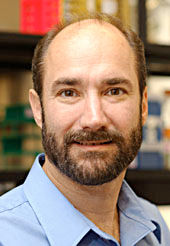New 'trick' allows HIV to overcome a barrier to infection
Advertisement
Researchers have discovered a new 'trick' that allows HIV to overtake resting T cells that are normally highly resistant to HIV infection, according to a report in Cell, a Cell Press publication. The binding of the virus to the surface of those cells sends a signal that breaks down the cells' internal skeleton, a structure that otherwise may present a significant barrier to infection.
Specifically, they show, binding of HIV to the receptor known as CXCR4 activates cofilin, a protein that disassembles actin microfilaments in the resting T cells. Those actin microfilaments are important building blocks of the cytoskeleton. That process is a required step for the virus to infect those resting cells, suggesting it may provide a useful new target for therapy, the researchers said.
"The ability of co-receptor engagement to alter intracellular biochemistry suggests that exposure of cells to HIV may in fact prime cells for HIV infection," said Yuntao Wu of George Mason University and Jon Marsh of the National Institute of Mental Health. This first identification of the necessity of receptor signaling for infection also suggests "that HIV's evolved selection of co-receptors is borne out of necessity."
In fact, the disassembly of actin microfilaments might actively assist HIV's entry into the nucleus, Wu added. "When actin is cut, it grows back. That process may carry the virus from the cortical actin to inside the nucleus."
" It's probably not just the breakdown of actin," Marsh agreed. Rather, he said, the rearrangement of actin may actively permit HIV's transport to the nucleus. In support of that notion they found that complete actin breakdown hinders the virus's ability to infect.
Earlier studies had shown that HIV relies on two CD4 coreceptors on the surface of T cells, CCR5 and CXCR4. CCR5 is expressed on activated, memory T cells where it plays a critical role in the susceptibility to HIV infection.
On the other hand, infection of resting T cells via CXCR4 seemed a more restricted process. Yet, in nearly one-half of the HIV-infected population, there is a conversion late in the disease to CXCR4 utilization, corresponding to an accelerated drop in T cell numbers, the researchers said.
Evidence had surfaced suggesting that the ability of HIV to establish itself in resting T cells, albeit slowly, is not purely passive, the researchers noted. Rather, studies had hinted that HIV may alter the cellular environment to facilitate infection and subsequent viral production. The new findings confirm that notion.
HIV's newfound ability to rearrange the cytoskeleton of resting T cells with the help of cofilin may not be necessary in active memory T cells, Wu explained. That's because cells that are actively cycling and migrating disassemble elements of the cytoskeleton themselves, leaving them naturally more susceptible to HIV's entry.
"This is the first time we've been aware of cofilin's activity in HIV infection of resting CD4 T cells," Wu said. Further study is required to identify exactly how the virus interacts to effect this change in cells and to further explore its potential as a target for treatment.
"This shows how much more we can learn," Marsh added. "HIV has evolved to utilize a great number of normal cellular processes. This is just another one."

























































